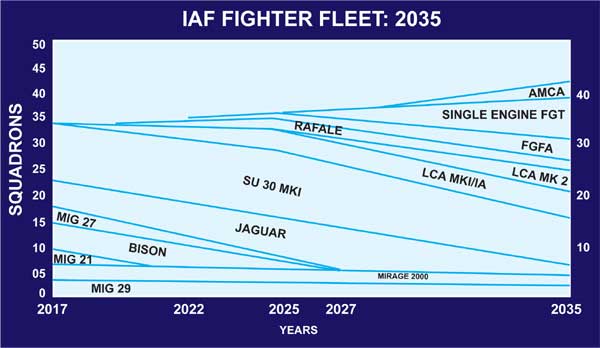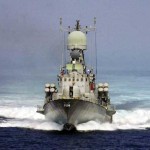Fighter Fleet Beyond 2030
The figure below is indicative of how the fleet will induct or phase-out in the unfolding years and physically, how the IAF will reach its targeted strength of 42 squadrons by my reckoning by 2035. The fleet of upgraded Mig-29 and Mirage-2000 are likely to extend till 2035 with additional upgrades. Upgraded SU-30 MKI with further upgrades of avionics and weapons the SU-30 MKI fleet will carry on till 2040. The DARIN III jaguars will fly till 2035. Over the coming years, the IAF will induct 40 LCA Mk I and has committed for 83 Tejas Mk IA forming six squadrons of the two variants. The Mk I will later be updated to Mk IA. Six LCA Mk IA squadrons are expected by 2025. Already contracted 36 Rafale aircraft will begin inducting in 2019, with all aircraft ‘IN’ by 2022. The Rafale fleet will fly till 2045.
The HAL Advanced Medium Combat Aircraft (AMCA) which is meant to replace the Jaguars and Mirage-2000 would be available only around 2030.
Four squadrons of LCA Mk II are planned. Mk II with the more powerful 98 kN thrust F414 engine, which is more likely to meet the LCA FOC, will be ready not earlier than 2022. The IAF should have around 100 LCAs in Mk 1A standard and another 80 in Mk II standard flying in 2030. Further orders will depend on progress or the LCA Mk II. The Mk II should see IAF through till 2040. The Indo-Russian Fifth Generation Fighter (FGFA) is still under development. Nearly 150 aircraft are meant to replace the MiG-27 and MiG-29s. The aircraft may be inducted only after 2022 and should see through till 2050. The HAL Advanced Medium Combat Aircraft (AMCA) which is meant to replace the Jaguars and Mirage-2000 would be available only around 2030. The IAF requires 250 AMCAs and may finally choose a single engine fighter aircraft between the Saab Gripen JAS 39 E and the F-16 Block 70. Since the final call will be taken after 2021, the aircraft may induct only around 2025 and then operate till 2045.
Hold Ups, Slips and Confusion
The LCA induction in July 2016 can, at best, be called ceremonial. The first squadron will really form an operational base in Sulur only in 2019. The LCA Mk IA will go through as it is quite straightforward with easy to handle changes. The LCA Mk II is a longer and taller variant of LCA Mk I and with new air-intakes and quite different aircraft with changed weight and C of G and other parameters. It will require extensive testing. With the past track record of the programme, induction in 2025 is a tall order. The CAG Report of 2015 has indicated that there are many holes to plug. Dependence on foreign suppliers for key systems such as engines, radars, EW systems, key avionics, and even ejection seats puts India at their mercy. Low production rate is also an impediment.
The FGFA is another project full of confusion. One gets a feeling that India is half-heartedly into the programme. Officially announced in 2007, it was to have 50:50 work and cost sharing. The ground reality is that today, HAL has only 15 per cent work share in this partnership. In 2010, Russia flew its own single-seat prototype even though the IAF was keen on a two-seat variant. By now, the IAF had assessed the project and given over 40 observations on technology, engine, stealth, maintainability and armaments among others. The Design and Development (D&D) budget has gone well beyond the $6 billion meant for each side. Initially both sides were to acquire 250 aircraft each; the numbers have since been scaled down. The IAF’s last known figure was down to 144. As India was still trying to make up its mind, Russia has started inducting its variant as SU-57 and is demanding $7 billion more for D&D of the two-seat variant for the IAF.
As the world moves towards sixth-generation fighter aircraft, India cannot be left far behind.
Though the Indian government has told the Russians that India was ‘ON’ in the project, physical contracting has still to take place. The grapevine is that the IAF may scale down numbers to 60-80. The DRDO’s ambitious AMCA programme is still on the design board, and considering the LCA track record and lack of core technologies, we may be pitching well beyond our abilities. AMCA operational capabilities and timelines appear very optimistic and unrealistic. While both the Lockheed Martin and SAAB have chosen big Indian industrial business partners and are aggressively marketing the F-16 Block 70 and SAAB Gripen JAS-39 E for the IAF’s single engine aircraft requirement competition, a key hurdle will be the Transfer of Technology which neither is willing to part for the moment. With such uncertainties, the grand plan till 2035 may hit many bumps on the way.
Alternative Options
In view of the delays and uncertainty in LCA Mk II, FGFA, AMCA, some alternative options may have to be exercised. 200 single engine aircraft would surely make up for delays in LCA and also give higher operational capability. India must seriously revisit the option of increasing the Rafale numbers by ideally manufacturing 90 aircraft through the Joint Venture route. Alternatively, at least 24 more aircraft could be purchased. Failing which, the IAF may even be forced to increase SU-30 MKI by another 40 aircraft. As yet another resort the IAF may consider adding numbers to its existing fleets by purchasing a few more second-hand Mirage-2000 and MiG-29s with reserve life and upgrade them. We may assemble another 20 Jaguars. The IAF fighter fleet serviceability continues to hang around 60 per cent. That implies that out of 800 combat aircraft, only 480 are flying fit. The government approved serviceability for operational planning is 75 per cent. If the IAF were to achieve this figure, it would add 120 additional serviceable aircraft. It would mean adding six squadrons. The main reason for low serviceability is the non-availability of critical spares, some of which may have gone for repairs. A one-time investment on spares could cost Rs 10,000 to 15,000 crore.
R&D and Indigenisation
The DRDO’s overstated capability and repeatedly long delayed timelines of the LCA programme have greatly affected the IAF’s acquisition plans and in turn, operational capability. DRDO, Ordinance Factories, and Defence PSUs have not delivered sufficiently in the last seven decades. Undoubtedly, the LCA programme helped India master, fly-by-wire, glass cockpit and composite material technologies, but core aircraft technologies are still only on paper. Pure scientific knowledge has not converted into substantial end-products. These organisations have not moved with the times and have serious structural limitations. Strategic divestment of these assets with Veto powers with government may improve performance and ease acquiring technologies. India has to increase funding for defence R&D well beyond its current $6 billion, bulk of which currently goes in salaries.
On an average, a mid-size fighter aircraft will cost $50 million. To acquire even just 15 squadrons over next decade, $14 billion will be required just for new aircraft.
Weapon Holdings and Force Multipliers
While it is always most glamorous to talk of fighter fleet numbers, but a critical aspect of operational ability is the weapon holdings. While IAF re-builds its fighter Squadrons, it must build up its inventory of Precision Guided Munitions (PGMs), cruise missiles, BVR and Close Combat missiles and Surface-to-Air Missile systems, including the Anti-Ballistic Missile system. The weapons inventory should be for at least 20 days of intense war. The IAF needs to triple its UAV fleet which will give value for money in operational returns. To take on China, or for a two-front war, the IAF requires at least 20 air refuelers and 20 AEW&C aircraft, many times more than its current strength.
Way Ahead
As the world moves towards sixth-generation fighter aircraft, India cannot be left far behind. If we can succeed in space and automobile sectors and be a leader in software, India has all the building blocks to master aircraft building technologies. It is time to get our act right. In the meantime, the defence of India from the air cannot be at the mercy of lower indigenous technologies or slow decision making for acquiring the minimal operational capabilities. All hurdles for the IAF to quickly reach the 42-squadron strength must be removed with national resolve. Increasing numbers of Rafale and SU-30 MKI fleet could be a viable immediate solution. We must target out-of-the-box solutions to improve fighter fleet serviceability to at least 75 per cent.
Accelerating indigenisation and procurements would be required. To replace the overdue for phasing out squadrons and to make good the shortfall of nine squadrons would require large allotment of funds. On an average, a mid-size fighter aircraft will cost $50 million. To acquire even just 15 squadrons over next decade, $14 billion will be required just for new aircraft. Weapons and ground infrastructure will add up to much more. The Union Budget 2017-2018 had $53 billion earmarked for defence. 90 per cent of the $18 billion earmarked for new acquisitions was required for committed liabilities of payments for earlier procurements. To make good the modernisation gap, a much higher defence budget, at least 2.5 per cent of GDP up from the current 1.65 per cent for about a decade is required.






India continues to recycle its decade old RFIs with only analysis paralysis to show for it while diminishing its offensive capability depleting its armaments on land air and sea while drastically falling way behind its enemy to the north. The situation is not any better in the department of defence where a general malaise seems to have to set in post the appointment of nirmala sitharaman. The make in india effort is struggling to breathe while the drdo is being crushed under its own weight. It would be a safe bet to say that prospects for improvement look pretty grim for the next decade as well. Wake up call anyone?
The bean counters in IAF and rest of India should stop counting beans. Planes are not the only part of India’s defense. At this stage of development India has other weapons/options to defend itself.
India should nurture its talent and provide jobs and opportunities to its own people so that they can design and develop their own planes and armed drones.
The next war is going to be fought with unmanned robots(planes, submarines, missiles, etc).
Build more SU30’s, buy more Rafale’s and manufacutre Tejas on a war footing. That is all that is needed. The next war will be fought with missiles and planes will be very vulnerable. Best they can do it to fire without crossing the border so hardly matters how sophisticated they are beyond a certain point. And who came up with the magic number of 42 squadrons anyway ? Chinese air force is very large and with the advanced anti aircraft missiles which all sides have, this number means nothing. Planes are needed to supplement the missiles once we start running out of them during an intense war. Other than that, not much a plane can do that a missile can’t do much more cheaply and safely.